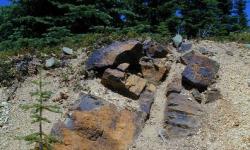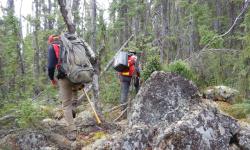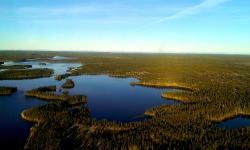Eagle Plains/Prize Mining Execute Letter of Intent to Form Joint-Venture to Produce Gold at Yellowjacket
British Columbia | February 28, 2009Cranbrook, B.C., 28 February, 2009: Eagle Plains Resources Ltd. (EPL:TSX-V) and Prize Mining Corp. (PRZ:TSX-V) jointly announce that the companies have executed a Letter of Intent containing the principle terms by which, subject to the satisfaction of certain conditions, the two parties will form a joint-venture to facilitate the production of gold and conduct further exploration and development of the Yellowjacket Zone on the Atlin Gold Property, located 9 kilometres east of Atlin, in north-western British Columbia.
Under terms of the Letter of Intent, Eagle Plains will purchase a 40% interest in the project by providing $2,000,000 CDN in working capital. These funds will be used to clear existing liens and obligations on the property, in addition to completing upgrades of the existing mill facility and covering costs related to engineering, permitting and environmental compliance. Eagle Plains will in turn receive 60% of all net proceeds of production up to $2,000,000, at which time it will revert to a 40/60 working interest. Eagle Plains will have the option of increasing its working interest to 60% by making payments to Prize totaling $2,000,000 by the sixth anniversary. It is expected that commercial production activity will commence by the third quarter of 2009. The joint venture remains subject to regulatory approvals and other customary conditions, including the execution of the definitive purchase and joint venture agreement.
Yellowjacket Zone History
The Yellowjacket Zone of the Atlin Gold Property is accessible year-round by all-weather road. The claims lie along the Pine Creek valley which is an historic and continuing placer gold producing area. Basic supplies and material to support mining activity can be readily sourced out of Atlin, and specialty services may be secured in Whitehorse, Yukon, located 180 kilometres north via Highway 7 and the Alaska Highway. Hydro-electric power has been recently established to within three kilometres of the property boundary.
The Atlin placer camp ranks as the second largest producer of placer gold in the province. Mining has been the economic mainstay for the town of Atlin since the discovery of gold on Pine Creek in 1897. The mineralized zone at Yellowjacket underlies significant historical surface disturbance. Downstream topographical features have rendered Pine Creek a “low-value” fish habitat.
Gold mineralization at Yellowjacket consists of coarse gold hosted in quartz stockworks and silicified zones in brittle volcanic and altered ultramafic rocks. Gold mineralization occurs along a prominent fault structure which is interpreted to control the distribution of placer gold reported in the area.
In 1983, local area prospectors staked the Yellowjacket Property, and subsequently optioned the property to Canova and Tri-Pacific Resources. During 1984 and 1985 these companies conducted programs of ground geophysics, rotary and diamond drilling. In 1986 Homestake Mineral Development Company optioned the property from Canova and from 1986 to 1988 initiated programs of mapping, reverse circulation drilling and diamond drilling (52 holes totaling 8,057 metres).
At the completion of this program, Homestake reported a resource estimate of 453,500 tonnes grading 10.26 g/t (Schroeter, T.G. and Pinsent, R.H; BC Ministry of Energy and Mines Open File 2000-2: Gold Production and Resources in BC (1858 - 1998). (Though these estimates are considered by Eagle Plains and Prize management to be relevant, they were prepared prior to the institution of National Instrument 43-101 standards. Their reliability has not been confirmed, but will constitute a target basis for future exploration work).
Prize Mining (formerly Muskox Minerals) optioned the property in 2003 and from 2003 to 2006 drilled 57 holes for a total of 6,873 metres. A number of impressive intercepts were encountered during drilling, with values ranging from “no significant results” to grades as summarized below:
| Drillhole | Interval | Width | Grade |
| YJ03-01 | 13.95m to 19.51m | 5.56m | 513.5 g/t Au |
| YJ04-07 | 48.85m to 54.45m | 6.10m | 40.1 g/t Au |
| including: | 53.95m to 54.45m | 0.31m | 588.9 g/t Au |
| TW05-02 | 10.67m to 12.79m | 2.62m | 853.0 g/t Au |
| including: | 10.67m to 11.58m | 0.91m | 2,397.0 g/t Au |
| TW05-02 | 20.05m to 41.50m | 21.45m | 11.5 g/t Au |
The general area encompassed by drilling covers approximately 300 metres x 100 metres, with the deepest mineralized intersection encountered at 140 metres. The deposit appears to be open along strike in both directions and to depth.
The Yellowjacket Zone coarse gold mineralization has a pronounced “nugget effect” where adjacent samples within the same mineralized zone can have widely varying gold values. This prompted Prize in 2006 to proceed with a bulk-sampling program in order to evaluate the deposit in an economic framework. Prize engaged a number of prominent engineering, metallurgical and environmental consultants to carry out permitting, pit design, mill design and fabrication work. Regular consultation was made with the Taku River Tlingit First Nation (“TRTFN”).
Excavation activity commenced in 2007 under a 10,000 tonne bulk sample permit. A modern milling facility was constructed, and includes a 1000 kW generator, ball mill, SAG mill, feeders, pumps, conveyors, three Knelson concentrators, magnetic separator, Diester and Gemini tables and an on-site assay laboratory. Test work indicated preliminary recoveries of 81%, with ore head-grades of approximately 9.0 g/t gold. Test work done on the rock units excavated from the pit have found them to be non-acid generating.
Consultants retained by Prize have recommended modifications to the mill circuit that are expected to increase recoveries to 90% and capacity to 350 tonnes per day. Work from 2003 until present has been carried out under the supervision of Linda Dandy, P.Geo., who will continue with the project as Mine Manager.
Eagle Plains and Prize Mining presently intend to meet the following objectives during 2009 pursuant to the joint venture agreement:
- compile all existing geological, geophysical, environmental and engineering data into a GIS database
- remove liens and encumbrances on the property
- complete application for BC Small Mines Permit (up to 75,000 tonnes per year)
- complete modifications to existing mill facility
- resume milling of stockpiled ore
- dewater existing pit
- commence expansion of existing pit
- commence commercial production with target of 35,000 tonnes throughput during Q3
- explore possibilities for year-round custom milling
- study feasibility of connecting to newly established hydro-electric facility
- design and execute exploration program for future expansion
Tim Termuende, President and CEO of Eagle Plains states “we are excited about participating with Prize Mining on this project. We recognize the quality and incredible amount of work required to bring the project to this stage, and are pleased to be able to provide financial and technical assistance to advance it, ultimately to the benefit of the local community, the Taku River Tlingit First Nation, Prize Mining and shareholders of Eagle Plains”. Harry McGucken, President of Prize Mining, added “we are extremely pleased with this new association and what Eagle Plains and its team bring to this project. The addition of their technical expertise will now enable the project to get to the next level of development for the benefit of all concerned”.
The proposed Yellowjacket Joint Venture will be committed to working on the Yellowjacket project in a sustainable and responsible manner. The project is situated within the traditional territory of the TRTFN, and as such, will only move forward with the trust and support of the TRTFN leadership and membership, and the people of the Atlin community. The project proponents look forward to establishing a strong relationship with all stakeholders, based on responsible economic and environmental stewardship and mutual respect.
About Eagle Plains Resources
Eagle Plains Resources continues to conduct research, acquire and explore metal projects in western Canada. The Company controls over 35 gold, base-metal and uranium projects, many with third parties including Teck Limited (TSX:TCK.B), Alexco Resource Corp. (TSX-V:AXR), Sandstorm Resources Ltd. (TSX-V:SSL.P), Waterloo Resources Ltd (TSX-V:WAT.P), Mountain Capital Inc. (TSX-V:MCI.P) and XO Gold Resources Ltd. (a private B.C. company). These agreements expose Eagle Plains to over $15.0 million in exploration expenditures over a five year period. In recent years, Eagle Plains has completed option agreements with Billiton Metals, Rio Algom Exploration, NovaGold Resources, Kennecott Exploration and numerous other junior exploration companies, resulting in over 52,000m (158,500') of drilling and over $27.0 million in exploration spending on its projects since 1998. 2008 expenditures on Eagle Plains' projects were approximately $6,000,000, funded equally between Eagle Plains and third party partners. In 2009, management anticipates approximately $1.2 million in exploration expenditures funded by partners.
This news release has been reviewed and approved by Tim J. Termuende, P.Geo., hereby designated as a “Qualified Person” under National Instrument 43-101.
On behalf of the Board of Directors
“Tim J. Termuende”
President and CEO
For further information on EPL, please contact Mike Labach at 1 866 HUNT ORE (486 8673)
Email: mgl@eagleplains.com or visit our website at http://www.eagleplains.com
Cautionary Note Regarding Forward-Looking Statements
Neither the TSX Venture Exchange nor its Regulation Services Provider (as that term is defined in the policies of the TSX Venture Exchange) accepts responsibility for the adequacy or accuracy of this release. This news release may contain forward-looking statements including but not limited to comments regarding the timing and content of upcoming work programs, geological interpretations, receipt of property titles, potential mineral recovery processes, etc. Forward-looking statements address future events and conditions and therefore, involve inherent risks and uncertainties. Actual results may differ materially from those currently anticipated in such statements.
Latest News Releases

Eagle Plains Partner Earthwise Completes Data Review of the Iron Range Gold Project, British Columbia

Eagle Plains and Sun Summit Minerals Execute Option Agreement for the Theory Copper-Gold Project, British Columbia

Eagle Plains and Earthwise Minerals Execute Option Agreement for the Iron Range Gold Project, British Columbia

Eagle Plains and Partner Refined Energy Receive Permit for Drilling at Dufferin West Uranium Property, Saskatchewan

Eagle Plains Announces Letter of Intent with Earthwise Minerals for Option of the Iron Range Project, British Columbia

